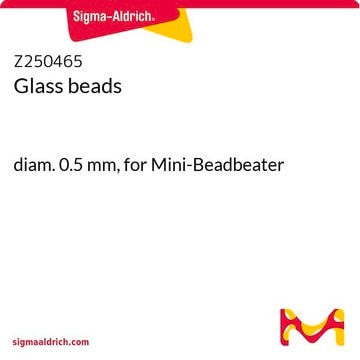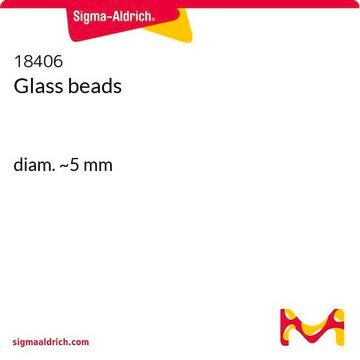G1152
Glass beads, acid-washed
710-1,180 μm (16-25 U.S. sieve)
Synonym(s):
Glass Beads
Sign Into View Organizational & Contract Pricing
All Photos(3)
About This Item
UNSPSC Code:
41102422
NACRES:
NB.22
Recommended Products
particle size
710-1,180 μm (16-25 U.S. sieve)
Application
Acid-washed glass beads have been used:
- in the extraction of proteins from antigen-expressing transgenic lines of Nicotiana tabacum L.
- to extract DNA of Candida albicans from human and murine blood samples
- to measure lipid yield from microalga C.homosphaera by adopting different methods of cell disruption methods
Storage Class Code
11 - Combustible Solids
WGK
nwg
Flash Point(F)
Not applicable
Flash Point(C)
Not applicable
Personal Protective Equipment
dust mask type N95 (US), Eyeshields, Gloves
Certificates of Analysis (COA)
Search for Certificates of Analysis (COA) by entering the products Lot/Batch Number. Lot and Batch Numbers can be found on a product’s label following the words ‘Lot’ or ‘Batch’.
Already Own This Product?
Find documentation for the products that you have recently purchased in the Document Library.
Customers Also Viewed
Novel strategy for microalgae cell disruption and wet lipid extraction by employing electro-Fenton process with sacrificial steel anode
Wanniarachchige P, et al.
Bioresource Technology (2022)
Katarina Damjanovic et al.
Microbial ecology, 79(3), 706-719 (2019-08-23)
Coral-associated bacteria are critical for the well-being of their host and may play essential roles during ontogeny, as suggested by the vertical transmission of some bacteria in brooding corals. Bacterial acquisition patterns in broadcast spawners remain uncertain, as 16S rRNA
Continued expression of plant-made vaccines following long-term cryopreservation of antigen-expressing tobacco cell cultures
Van E J and Keen P.
In Vitro Cellular & Developmental Biology. Plant, 45(6), 750-757 (2009)
Evaluation of a digital microfluidic real-time PCR platform to detect DNA of Candida albicans in blood
W. A. Schell
European Journal of Clinical Microbiology & Infectious Diseases : Official Publication of the European Society of Clinical Microbiology (2012)
Sarah L Sokol et al.
eLife, 7 (2018-05-23)
Most eukaryotic parasites are obligately heteroxenous, requiring sequential infection of different host species in order to survive. Toxoplasma gondii is a rare exception to this rule, having a uniquely facultative heteroxenous life cycle. To understand the origins of this phenomenon
Our team of scientists has experience in all areas of research including Life Science, Material Science, Chemical Synthesis, Chromatography, Analytical and many others.
Contact Technical Service












